The Rise and Fall of the Green Fairy
September 2014
By Annette Cook, MAC Lab Public Archaeology Asst.
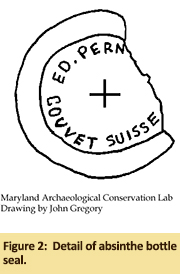
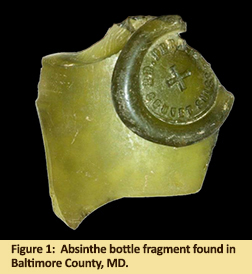 An intriguing bit of glass was found by an amateur archaeologist near the Liberty Reservoir in Baltimore County, MD. The bright green bottle glass fragment features a partial seal “ED. Pern, Couvet Suisse” around a central cross. (Figures 1 and 2) Rather than wine, this bottle held absinthe, a powerful, emerald green, anise flavored beverage featuring wormwood as one of its principle elements. This bottle was produced by the Edouard Pernod Distillery in Couvet, Switzerland and probably dates from between 1835 and 1897, when the company moved to France.
An intriguing bit of glass was found by an amateur archaeologist near the Liberty Reservoir in Baltimore County, MD. The bright green bottle glass fragment features a partial seal “ED. Pern, Couvet Suisse” around a central cross. (Figures 1 and 2) Rather than wine, this bottle held absinthe, a powerful, emerald green, anise flavored beverage featuring wormwood as one of its principle elements. This bottle was produced by the Edouard Pernod Distillery in Couvet, Switzerland and probably dates from between 1835 and 1897, when the company moved to France.
Wormwood preparations are recorded as being used by the ancient Egyptians and Greeks for medicinal purposes. The origins of modern absinthe are somewhat murky. A French doctor, Pierre Ordinaire, began the first commercial production of the elixir, hailing it as a cure for anemia, epilepsy, gout, worms, and all ills between. Upon the death of Ordinaire, the recipe reputed to be his came into the possession of a Major Dubied, who began a larger scale production of the beverage, now touted as an aperitif, with his son-in-law Henri Louis Pernod around 1797. Henri became the father of the Pernod brand, and his sons Edouard and Louis opened their own distilleries in Couvet, Switzerland and Pontarlier, France. Eventually Edouard moved his distillery to Pontarlier as well.
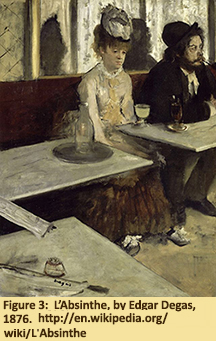 French soldiers in the 1840s were given absinthe as an anti-malarial, and upon returning home, continued to seek out the beverage. Further fueling absinthe’s rise in popularity was the Europe-wide “wine blight” of the late 19th century, which caused wine production to plummet and prices to skyrocket. Although considered by some as a beverage for the elite, absinthe gained a following amongst the bourgeoisie, as well as the Bohemian crowd of artists and intellectuals. Artists such as Van Gogh and Gaugin, and poets including Oscar Wilde, embraced “The Green Fairy,” as their preferred beverage. Absinthe drinking, particularly in France, became so prevalent that the period between 5 and 7 pm was referred to as the Green
French soldiers in the 1840s were given absinthe as an anti-malarial, and upon returning home, continued to seek out the beverage. Further fueling absinthe’s rise in popularity was the Europe-wide “wine blight” of the late 19th century, which caused wine production to plummet and prices to skyrocket. Although considered by some as a beverage for the elite, absinthe gained a following amongst the bourgeoisie, as well as the Bohemian crowd of artists and intellectuals. Artists such as Van Gogh and Gaugin, and poets including Oscar Wilde, embraced “The Green Fairy,” as their preferred beverage. Absinthe drinking, particularly in France, became so prevalent that the period between 5 and 7 pm was referred to as the Green 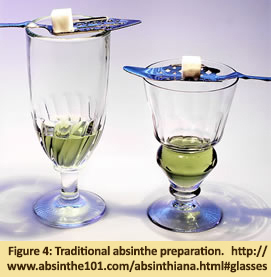 Hour. Many artworks from this period include depictions of absinthe drinking (Figure 3). Visitors to France and Switzerland carried absinthe’s popularity back to their home countries, including the United States.
Hour. Many artworks from this period include depictions of absinthe drinking (Figure 3). Visitors to France and Switzerland carried absinthe’s popularity back to their home countries, including the United States.
Though absinthe was used in a variety of concoctions, the most popular way to serve it was, and is, as follows. A bulbous absinthe glass was often used. The bulb size indicated the amount of absinthe to be poured. A single sugar cube on a special absinthe sugar spoon was placed over the top of the glass and ice cold water was poured over the sugar cube (Figure 4). Experts recommend an ultimate mix of 1 part absinthe to 3 parts water. Water is thought to release the drink’s herbaceous notes, as well as to dilute its famously high alcohol content. Most absinthes range between 110 and 144 proof. A potent brew indeed!
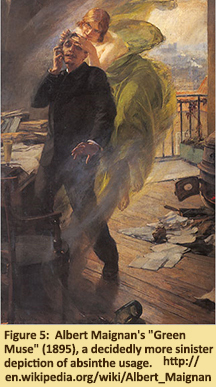 Later in the 19th century, concern began to grow about the popularity of absinthe. Cheaper imitations of recognized brands began to be produced, with varying levels of quality and of thujone, the chemical from wormwood which some blame for the drink’s supposed hallucinogenic effects. Rumors of the ill effects of absinthe began to circulate, though such effects were probably due to general alcohol abuse. Once hailed as a cure, the beverage was now blamed for causing illness and madness amongst its users. At this time, wine production also began to stabilize, and winemakers, in an effort to win back customers, began to join temperance leaders in discrediting absinthe. Even artist’s depictions of absinthe use began to be negative. (Figure 5). By the turn of the 20th century the Green Fairy was becoming the Green Curse.
Later in the 19th century, concern began to grow about the popularity of absinthe. Cheaper imitations of recognized brands began to be produced, with varying levels of quality and of thujone, the chemical from wormwood which some blame for the drink’s supposed hallucinogenic effects. Rumors of the ill effects of absinthe began to circulate, though such effects were probably due to general alcohol abuse. Once hailed as a cure, the beverage was now blamed for causing illness and madness amongst its users. At this time, wine production also began to stabilize, and winemakers, in an effort to win back customers, began to join temperance leaders in discrediting absinthe. Even artist’s depictions of absinthe use began to be negative. (Figure 5). By the turn of the 20th century the Green Fairy was becoming the Green Curse.
In 1905, possibly nailing the coffin on the decline of the drink, a French laborer named Jean Lanfray, after a day of heavy drinking, murdered his pregnant wife and two children. Despite evidence that absinthe accounted for very little of the alcohol Lanfray had consumed that day, the temperance movement grabbed onto this crime as proof of the beverage’s harmful effects and called for it to be banned. By 1910, absinthe had been banned in its home country of Switzerland. Bans followed in many countries, including the US in 1912 and France in 1915.
It is only recently that most bans on absinthe have been lifted. The Swiss ban was lifted in 2005, and the U.S. in 2007. In some countries, including the U.S., strict limits remain as to how much thujone absinthe may contain. In France, absinthe remained illegal until 2011, although legal loopholes allowed some distillers to continue producing similar products under different names. Only time will tell if the Green Fairy will ever rise to its pre-ban level of popularity.